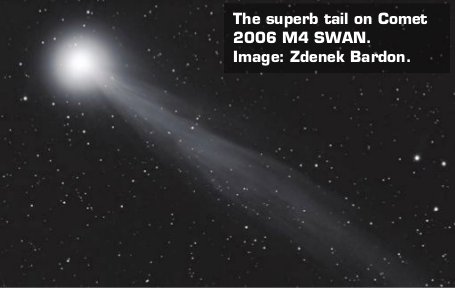Comets - Where and When?
- Introduction
- Comets
- Asteroids
- Meteorites
- Meteor Showers
- Rock Types
- Identification
- Origins
- Destruction
Click here for the PDF Download of this booklet
Next Page: Comets - Why?
If comets had formed too close to our stellar neighbour, the Sun’s radiation would have driven off all the ices that coat the nucleus. Therefore, comets had to form beyond the snow line – the region in the early Solar System where substances like water and ammonia were able to exist as ice grains rather than vapour. In protoplanetary nebulae the snow line occurs where temperatures drop below minus 123∘C (150 K), dependent on density and pressure, and the boundary to the snow line was roughly where we find Saturn today.

As the Solar System coalesced from the spinning, chaotic protoplanetary nebula, cometary bodies fell into distant orbits around the Sun, discarded from the planetary construction yard. Their new home was the Kuiper Belt – a disc of icy bodies beyond Neptune, extending up to 12 billion km from the Sun – or even further beyond that, the Oort Cloud, a spherical swarm of trillions of frozen comets that could possibly stretch out as far as half way to the nearest star. Today, not every comet hails from these distant locales; some pass regularly through the Solar System.
We divide comets into classes depending upon their orbits. Short period comets are split into two groups, Jupiter-family comets and Halley- family comets. The Jupiter- family comets typically have orbital periods of less than 20 years, and their elliptical orbits lie in the plane of the Solar System. They are dominated by the gravitational influence of Jupiter. The Halley- family comets, named after the most famous comet of all, have orbital periods of less than 200 years and can escape to as far away as Neptune’s orbit before looping back towards the Sun. Halley, for instance, returns every 76 years.
Then there are the long period comets such as Hale-Bopp and Hyakutake, which we might be lucky to see every few millennia (Hale-Bopp’s orbital period is 2,400 years, whilst Hyakutake’s is 20,000 years). Finally there are the one-off comets that race through the Solar System on a parabolic trajectory, before the Sun’s gravity ejects them from the Solar System on a one-way ticket into interstellar space.

Over 3,500 comets have been identified so far, 400 of which are short-period comets while 1,500 have been found to be Sun-grazers. These are comets that fly perilously close to the Sun, and some are even unfortunate enough to hit the Sun and be destroyed.
We can predict the orbits of the comets we know about, but one-off comets, or long period comets that are just swinging around in our direction for the first time in millennia, often come as a complete surprise. So it is not always possible to predict when the next great comet will be – some of the best such as Hyakutake in 1996 have come out of nowhere to amaze us.
Next Chapter: Comets - Why?


